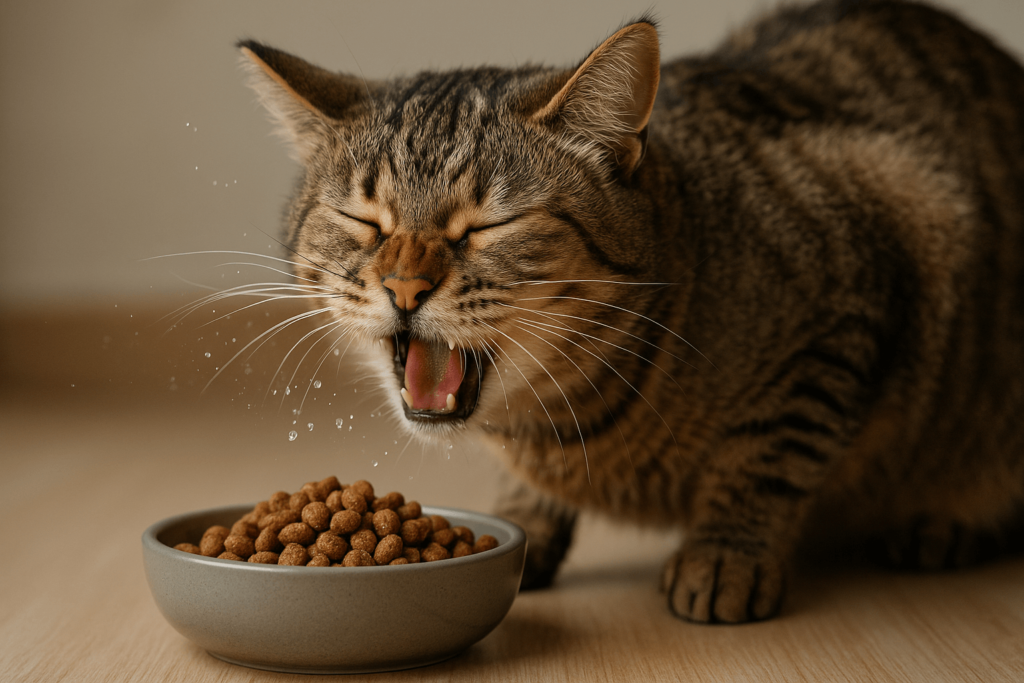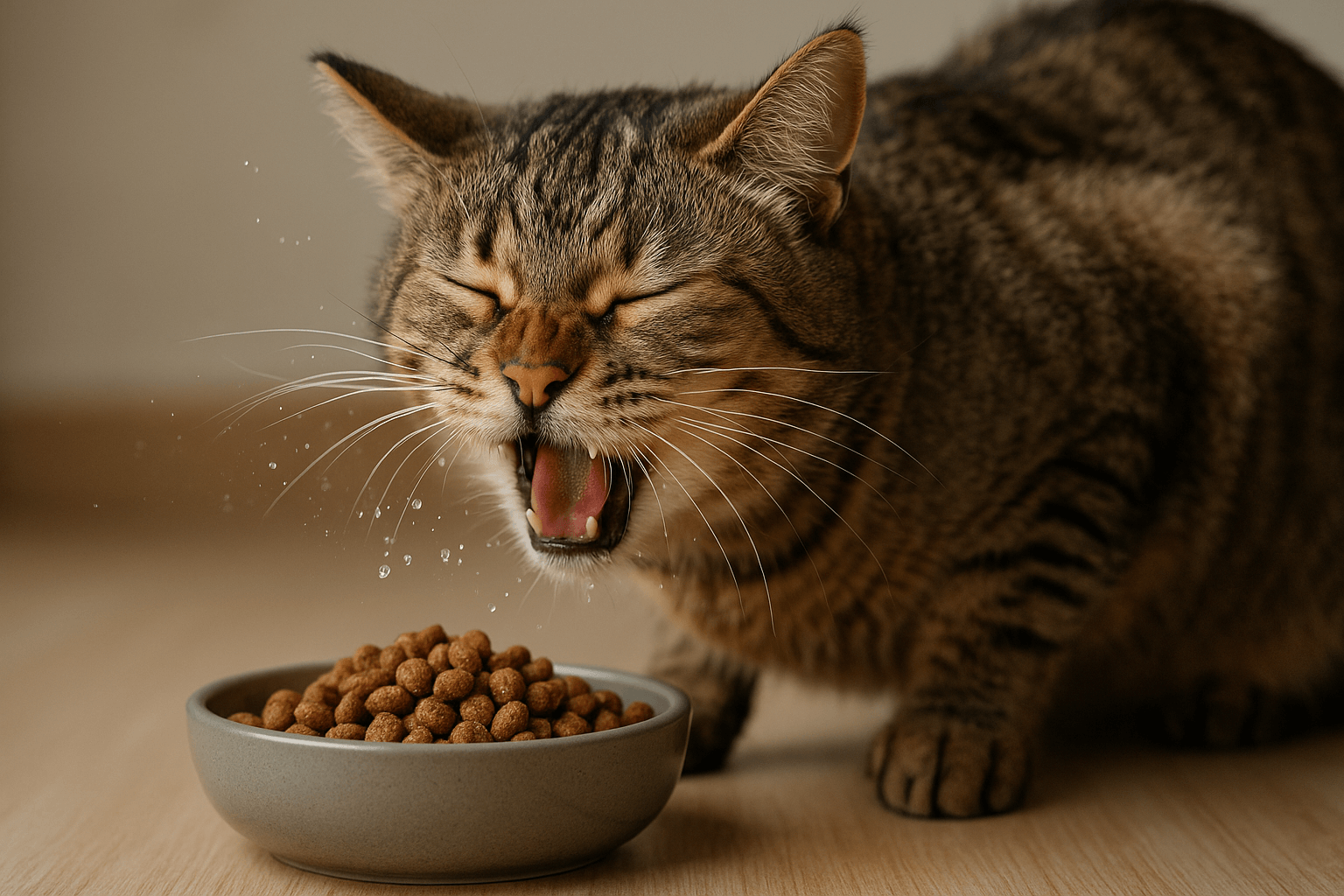Why Is My Cat Sneezing When Eating?
Cats are known for their quirky behaviors, but sneezing during meals can be concerning for pet owners. While occasional sneezes might not indicate a serious issue, persistent sneezing while eating could point to underlying problems that require attention. Understanding the potential causes and solutions can help you ensure your feline friend stays healthy and comfortable. In this blog post, we’ll explore why cats sneeze when eating, how to identify warning signs, and what steps you can take to address the issue effectively.
Common Causes of Sneezing While Eating
There are several reasons why your cat might sneeze during meals. Identifying the root cause is essential for addressing the problem appropriately.
Food Particles Irritating the Nose:
Small crumbs or bits of food may accidentally enter the nasal passages, triggering a sneeze reflex as the body tries to expel them.Strong Food Aromas:
Cats have sensitive noses, and strong-smelling food—especially wet or fish-based options—can irritate their nasal passages and cause sneezing.Allergies to Ingredients:
Certain ingredients in your cat’s food may trigger allergic reactions, leading to sneezing, itching, or other symptoms.Dental Issues:
Dental problems like gum disease or tooth decay can cause discomfort and sneezing, particularly if inflammation affects nearby nasal tissues.Respiratory Infections:
Upper respiratory infections can make sneezing more frequent, especially during activities like eating that involve deep breathing.
Recognizing these potential triggers allows you to narrow down the cause and take appropriate action to help your cat feel better.

Signs Your Cat’s Sneezing Requires Veterinary Attention
While occasional sneezing is normal, certain red flags indicate the need for professional evaluation. Here’s what to look out for if your cat sneezes while eating.
Frequent or Persistent Sneezing:
If sneezing occurs multiple times a day or becomes a regular occurrence, it may signal an underlying health issue.Nasal Discharge:
Clear discharge is less concerning than yellow, green, or bloody mucus, which could indicate infection or trauma.Loss of Appetite:
Sneezing accompanied by a refusal to eat suggests pain, discomfort, or illness requiring immediate attention.Difficulty Breathing:
Labored breathing or wheezing alongside sneezing points to potential respiratory or airway issues.Behavioral Changes:
Lethargy, irritability, or withdrawal from usual activities may signify that your cat is unwell and needs medical care.
Understanding these warning signs ensures you seek timely veterinary assistance to protect your cat’s health.
Check this guide 👉Why Is My Cat Sneezing Mucus? Best 7 Expert Tips!
Check this guide 👉Why Does My Cat Sneeze So Much? Best 7 Expert Tips!
Check this guide 👉Why Is My Cat Sneezing Blood? Best 7 Expert Tips!
Preventive Measures for Sneezing | When to Consult a Vet |
|---|---|
Feed high-quality, hypoallergenic food | Frequent or chronic sneezing |
Check for food debris near the nose | Noticeable nasal discharge |
Maintain good oral hygiene | Difficulty breathing or swallowing |
Avoid strong-smelling foods | Loss of appetite or weight loss |
Monitor for environmental allergens | Behavioral changes or lethargy |
How to Prevent Sneezing During Meals
Taking preventive measures can reduce the likelihood of your cat sneezing while eating. These tips focus on creating a safer and more comfortable mealtime experience.
Choose Appropriate Food Bowls:
Elevated or shallow bowls can help minimize the risk of food particles entering the nasal passages.Serve Smaller Portions:
Breaking meals into smaller portions encourages slower eating, reducing the chance of inhaling food particles.Inspect Food Quality:
Ensure your cat’s food is free from contaminants, additives, or allergens that could irritate their system.Clean Feeding Area Regularly:
Remove leftover crumbs or residue around the feeding area to prevent accidental inhalation.Monitor for Allergens:
Keep an eye on environmental allergens like dust or pollen that could worsen sneezing during meals.
Implementing these strategies promotes healthier eating habits and reduces sneezing episodes.
Steps to Take if Sneezing Persists
If your cat continues to sneeze despite preventive efforts, it’s important to investigate further. These steps can guide you toward resolving the issue effectively.
Consult Your Veterinarian:
Schedule an appointment to rule out infections, allergies, or dental problems that might be contributing to sneezing.Perform an Allergy Test:
Request allergy testing to identify specific food or environmental triggers affecting your cat.Switch to Hypoallergenic Food:
Transitioning to hypoallergenic or limited-ingredient diets can help determine if food sensitivities are the culprit.Address Dental Health:
Have your cat’s teeth and gums examined for signs of decay, gum disease, or inflammation.Observe Environmental Factors:
Evaluate your home environment for potential irritants like cleaning products, scented candles, or smoke.
By systematically addressing possible causes, you can pinpoint the source of sneezing and implement targeted solutions.
Common Mistakes to Avoid
Avoiding common mistakes can make managing sneezing episodes easier and more effective. Here’s what to steer clear of when addressing this issue.
Ignoring Persistent Symptoms:
Overlooking ongoing sneezing delays treatment for potentially serious conditions. Always monitor patterns closely.Using Human Medications:
Never give over-the-counter medications to your cat without veterinary approval, as they can cause harm.Feeding Problematic Foods:
Continuing to feed foods that trigger sneezing prolongs discomfort and delays resolution.Skipping Regular Dental Checkups:
Neglecting dental health can lead to sneezing caused by undiagnosed oral issues.Overlooking Environmental Triggers:
Failing to identify allergens or irritants in your home can exacerbate sneezing episodes unnecessarily.
Avoiding these pitfalls ensures you handle sneezing incidents responsibly and effectively.
Tips for Introducing New Foods
Introducing new foods carefully can help determine if diet-related factors are causing sneezing. Follow these tips for a smooth transition.
Gradual Transition:
Mix small amounts of new food with the old gradually to avoid digestive upset or sudden reactions.Monitor Reactions Closely:
Observe your cat’s behavior and sneezing frequency after introducing each new ingredient.Stick to Simple Ingredients:
Choose foods with minimal ingredients to reduce the risk of triggering allergies or sensitivities.Offer Wet and Dry Options:
Experiment with both wet and dry food to see if texture impacts sneezing episodes.Document Observations:
Keep a journal of your cat’s responses to different foods to identify potential culprits.
Thoughtful experimentation helps pinpoint dietary triggers and supports better mealtime experiences.
Creating a Stress-Free Eating Environment
Reducing stress during mealtimes can minimize sneezing episodes and improve overall dining experiences for your cat.
Provide a Quiet Space:
Feed your cat in a calm, low-traffic area to minimize distractions and anxiety.Establish a Routine:
Stick to consistent feeding times and locations to build trust and predictability.Limit Competition:
Separate food bowls if you have multiple pets to prevent competition-induced stress.Use Calming Products:
Consider pheromone diffusers or calming sprays to create a soothing atmosphere.Encourage Slow Eating:
Puzzle feeders or slow-feeding bowls encourage mindful eating, reducing the risk of sneezing.
A stress-free environment fosters relaxation and minimizes sneezing triggers during meals.
Frequently Asked Questions About Cat Sneezing While Eating
Is it normal for cats to sneeze occasionally?
Yes, occasional sneezing is normal, but persistent sneezing warrants investigation.
Can dry food cause sneezing?
Dry food itself doesn’t typically cause sneezing, but crumbs or strong odors might contribute.
What should I do if my cat sneezes blood?
Seek immediate veterinary care, as bloody sneezes could indicate injury, infection, or a serious condition.
Can stress lead to sneezing?
Stress can weaken the immune system, making cats more prone to sneezing due to infections or irritants.
How can I clean my cat’s nose safely?
Use a damp cloth or cotton ball to gently wipe away any visible debris or discharge around the nostrils.
Ensuring Your Cat’s Comfort and Health at Mealtime
Sneezing while eating may seem minor, but it’s important to monitor your cat closely to rule out underlying issues. By understanding the causes, recognizing warning signs, and taking preventive measures, you can create a safe and enjoyable mealtime environment for your feline companion. Remember, your veterinarian is always the best resource for diagnosing and treating persistent sneezing. With proper care and attention, you can keep your cat happy, healthy, and sneeze-free during meals.
Canned Pumpkin for Cat Diarrhea: Best 7 Expert Tips! Natural remedy to firm stools, soothe upset bellies, and support gut health safely.
Can a Cat Give You Scabies? Best 7 Expert Tips! Discover the truth about feline mites, human skin risks, and how to protect yourself—without panic.
Cat Flea vs Human Flea: Best 7 Expert Tips! Discover the truth about bites, species, and how to eliminate infestations for good.
Weird Cat Behaviors: Best 7 Expert Tips! Discover why cats do strange things—and how to understand, not punish, their instincts for a happier home.





